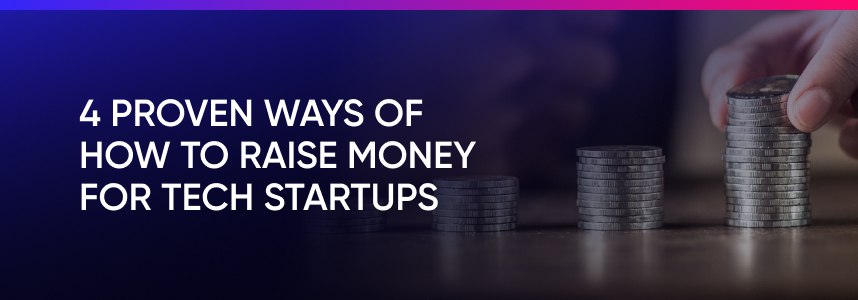Let’s work together to build something amazing. Share your project details and our team will reply to figure out the next steps to your success.

Starting a startup is no easy task, and one of the most significant challenges founders face is securing funding. In this comprehensive guide, we go into startup funding stages, from the initial “pre-seed” hustle to raising millions in venture capital and private equity rounds to the ultimate goal of an initial public offering (IPO). We explore the hurdles, strategies, and success stories at each stage, shedding light on startups’ journeys navigating the intricate world of funding and growth. Whether you’re a founder, investor, or simply curious about the startup ecosystem, this guide will provide valuable insights into the funding landscape and the stages that shape the trajectory of emerging businesses.

The Pre-Seed Hustle: How Startups Raise Their First $50K
Every startup begins with an idea, but turning that idea into reality requires capital. Most founders’ initial funding comes from their savings, credit cards, friends, and family. This “pre-seed” round is the first hustle to get a startup off the ground, usually raising between $10,000 to $50,000.
The Benefits of Pre-Seed Funding
With little more than a prototype and a pitch deck, pre-seed funding allows founders to get their startup into a position where it can raise an official seed round from outside investors. The money is used to develop an initial product, hire a small team, and gain traction to show investor potential. However, founders need help convincing others to invest in an unproven idea.
Pre-Seed Funding, the First Stage for Startups
Max Levchin, co-founder of PayPal, described starting a company as “staring into the abyss and eating glass.” Pre-seed funding represents the first bite of glass, fueled by passion and grit in the face of overwhelming odds of failure. Notable startups that began with pre-seed funding include Airbnb, Uber, and Dropbox.
Airbnb Seed Funding
Airbnb founders Brian Chesky, Joe Gebbia, and Nathan Blecharczyk maxed out their credit cards and raised $20,000 from Y Combinator to build their initial pitch deck and prototype. With little more than an air mattress and a website, the founders hustled their way into seed funding and grew the company into a multi-billion dollar business.
Uber and Dropbox
Similarly, Uber founder Travis Kalanick raised $200,000 from angel investors to launch UberCab in 2010. And Dropbox founders Drew Houston and Arash Ferdowsi raised $15,000 from Houston’s MIT professor and a few thousand more from a demo day to develop their initial product. These pre-seed funded companies demonstrate that with determination, a strong vision, and the ability to convince initial backers, startups can go from an idea to a fully operational company.
However, the odds of success are low at this stage. The lack of funding and resources means most startups fail due to running out of capital before gaining enough traction. But for founders with the perseverance to make it work, pre-seed funding represents the first step of many toward building a successful company. With enough hustle, smarts, and luck, startups can leverage their pre-seed funding to raise seed rounds and beyond to become industry leaders eventually.
The Seed Round: How Startups Raise $2M on Average
After bootstrapping and raising a pre-seed round, startups seek seed funding to scale their business. Seed rounds average $2.2 million, raised from angel investors, seed funds, and occasionally venture capital firms. With seed funding, startups can further develop their product, expand their team, and gain initial traction to raise a Series A round.
Angel Investors and Seed Funds
Prominent angel investors and seed funds include Y Combinator, Techstars, and 500 Startups. These investors look for scrappy, innovative startups with the potential for high growth. They invest smaller amounts, from $50,000 to $500,000 in exchange for equity in the startup. Angel investors are also more likely to invest in riskier startups at this stage.
Uber and Airbnb Seed Funding from Y Combinator & Angel Investors
For example, Uber raised $200,000 in seed funding from angel investors in 2010 to launch their platform in San Francisco. Another example is Airbnb, which raised $600,000 from Y Combinator and Sequoia Capital in 2009 to expand into new cities. Seed funding gave these startups the initial capital to build out their products, hire a small team, and gain enough traction to raise a Series A round.
Startups Face High Failure Rates in Early Stages
While seed funding is crucial for early startups, the failure rate at this stage is high. According to research by CB Insights, 67% of seed-funded startups do not raise follow-on funding. Without additional capital, most seed-funded startups eventually shut down. This is because they cannot attract Series A investors, run out of cash to continue operating, or need more traction to justify more funding.
Metrics and Customer Growth Lead to Series A Funding
However, for startups that can demonstrate promising metrics around customer growth, engagement, and retention, raising Series A is the next step. Series A rounds are much larger, averaging $15.6 million, and allow startups to scale rapidly. Investors at this stage are traditional venture capital firms looking for startups that have the potential to disrupt industries and build a sustainable, high-growth business. With more capital and resources, startups have a higher chance of success, though they still face high failure rates compared to later stages.
Seed funding is crucial for early startups but comes with a high chance of failure. For scrappy startups with the potential for high growth, raising a seed round from angel investors and seed funds allows them to launch their businesses. But only a fraction go on to raise Series A and beyond. Startups that gain enough traction to justify Series A have a higher likelihood of success and the opportunity to scale into viable, high-growth companies.
The Series A Crunch: Why 90% of Startups Don’t Make It
Series A is a startup’s first round of venture capital funding. However, less than 10% of seed-funded startups successfully raised Series A due to intense competition. For early-stage startups, raising Series A funding is a pivotal milestone.
What are the Benefits of Series A Funding?
On the one hand, Series A allows startups to scale fast by hiring more talent, expanding into new markets, and building key partnerships. With fresh capital and the validation of reputable VC investors, startups gain more credibility and visibility. This can help attract top talent and new customers.
Stakes are High at the Series A Stage
Failure rates for startups are the highest after Series A due to fast growth and competitive pressures. Investors expect Series A startups to demonstrate a proven business model, strong traction, and a path to profitability to justify higher valuations. This is difficult for most seed-funded startups.
Rejection is Common for Seed-funded Startups
According to CB Insights, over 70% of seed-funded startups do not raise follow-on funding. After being rejected by over 100 investors, Pinterest struggled to raise Series A and was close to shutting down. Multiple investors also rejected Airbnb before raising $7.2M in Series A.
For startups, raising Series A requires a relentless focus on growth and key milestones to overcome investor skepticism. This includes refining the product-market fit, building a scalable business model, and gaining substantial initial traction to prove the startup’s potential for high growth and venture-scale returns.
With limited capital and resources, most seed-funded startups cannot achieve these milestones and gain investor confidence in time. Hence, Series A is a make-or-break moment where startups either scale fast with VC funding or risk shutting down due to a lack of capital and growth. Overall, the Series A crunch highlights startups’ immense challenges in transitioning from seed-stage to established high-growth companies.
The Growth Rounds: Series B, C, and Beyond
For startups that successfully raise Series A and surpass the initial “Series A,” raising Series B and beyond are “growth rounds” to rapidly scale the business. Series B is a startup’s second round of venture capital funding, averaging $32.6 million, according to Pitchbook. Investors in Series B rounds include venture capital firms specializing in high-growth startups.
Series B Funding
With Series B funding, startups can expand into new markets, build out additional product lines, and acquire competitors to cement their position in the industry. For example, Facebook raised $12.7 million in Series B funding in 2005 to expand beyond college students and enter new geographic markets. This growth round was crucial to Facebook’s early success in overcoming competitors like Myspace and Friendster.
Series C and Series D
Series C and Series D rounds average between $50 to $100 million, allowing startups to make bigger bets on growth. For instance, Uber raised $258 million in Series D funding in 2013 to launch UberX, expand internationally, and accelerate the rollout of its service to new cities. These massive rounds signify that startups have achieved substantial scale and market traction, justifying much higher valuations.
The Downsides of Raising Larger Growth Rounds
However, greater pressure to generate results comes with larger growth rounds. Startups not only have to deploy much more capital, but they also have to meet ambitious growth targets to raise subsequent rounds. Investors expect Series B and beyond to fuel exponential growth, as anything less may signal problems with the business model or management team. As such, failure rates remain significant even at later funding stages.
Startups Must Show a Path to Profitability
A startup’s ability to raise Series B and beyond ultimately depends on demonstrating a sustainable path to profitability. While high growth is important, investors want to see how startups can eventually convert revenue into profits. Those unable to outline a realistic profitability timeline will struggle to raise additional funding as investors shy away from subsidizing unsustainable businesses in the long run.
Series B and growth rounds are pivotal to helping successful startups scale into viable businesses. But with more funding comes more significant responsibilities and pressures to achieve substantial growth, build a profitable model, and gain market leadership—or risk becoming another startup failure statistic.
The Private Equity Round: Startups Raise $100M to $1B
For highly successful startups that have gained substantial scale and traction, raising funding from private equity firms allows them to raise between $100 million to over $1 billion to make strategic acquisitions, expand into new global markets, and strengthen their position for an eventual IPO. By this stage, startups have proven their business model’s sustainability and high growth potential, thus commanding much higher valuations from sophisticated private equity investors.
Private Equity Firms
Private equity firms, such as Fidelity, TPG Capital, and The Carlyle Group, invest in mature startups with a track record of success and the potential for high returns. Raising a private equity round provides startups with a large cash infusion to gain an edge over competitors and new opportunities for rapid growth. For example, SpaceX, the aerospace manufacturer and space transportation services company, raised $1.6 billion in private equity funding from Fidelity and Google in 2015 to support their ambitious goals of revolutionizing access to space and making life multi-planetary.
Make Strategic Decisions and Strengthen Market Position
With access to significantly more capital, private equity rounds allow startups to strategically acquire competitors, suppliers, or customers to strengthen their market position. They can also use the funding to expand into new global markets, build additional product lines, and attract top talent with high compensation and equity packages. At this stage, startups are poised to become industry leaders and prepare to raise additional large funding rounds through an IPO.
The Setbacks of Private Equity Funding
However, private equity funding does come with strings attached and potential downsides for startups. Investors at this stage expect very high returns on their large investments within 3-5 years. This pressure can influence startups to prioritize short-term gains over long-term growth. Private equity investors also often receive board seats and a degree of control over the startup’s strategic direction. If key milestones are not met, investors may push for an early exit through a sale of the company. While private equity can be instrumental in fueling a startup’s ambitious vision, founders must go in with realistic expectations about the level of oversight and urgency for returns.
For startups with a proven track record of success, raising a large private equity round can be a pivotal moment that provides the capital and resources to scale into an industry leader. But founders must ensure they do not give up too much control or get locked into unrealistic short-term expectations in exchange for accessing this large pool of capital. With the right balance, private equity funding and strategic guidance can help propel a startup to success.
The Final Frontier: How Startups Raise Over $1B at IPO
For startups that successfully navigate the gauntlet of raising seed, venture capital, and private equity funding, an initial public offering (IPO) represents the final frontier. An IPO is a startup’s debut on a public stock exchange, allowing it to raise over $1 billion from a diverse range of public market investors.
Launching an IPO
Launching an IPO signifies a startup’s maturity and transition into a publicly-traded company. It means the startup has built a sustainable high-growth business, achieved substantial scale and profitability, and is ready for more scrutiny and regulation from being publicly traded. For founders and early investors, an IPO also represents an opportunity to partially cash out their equity stakes, which may have been illiquid for over a decade.
The Cost and Risks of Launching an IPO
The stakes for an IPO are high, with the average launch cost exceeding $4 million. Startups must meet stringent regulatory requirements, open their books to public scrutiny, and risk underwhelming public markets. However, successful IPOs can raise billions of dollars to accelerate growth, as Facebook raised $16 billion in its 2012 IPO.
Notable IPOs – Facebook, Alibaba, Snap, Spotify, and More
Well-known startups that have launched successful IPOs include Facebook, Alibaba, Snap, Spotify, Pinterest, and Zoom. Their IPOs raised billions of dollars and marked their transition into becoming publicly-traded industry leaders. For other startups, the lure of an IPO remains elusive, with many instead opting to be acquired by larger companies.
IPO – The Pinnacle of Startup Funding
An IPO represents the pinnacle of startup funding, open only to an elite group of private companies that have built sustainable high-growth businesses. For startups with ambitions to become major publicly-traded companies that shape industries, an IPO is the only path to unlocking access to billions of dollars in public capital and cementing their status as mature market leaders. With great funding comes great responsibility, and only the most promising startups that demonstrate a proven track record of success can seriously contemplate navigating the final frontier of raising over $1 billion through an initial public offering.
FAQ
How does a startup determine the right time to transition from one funding stage to another?
The timing of transitions between startup funding stages largely depends on achieving key milestones. These milestones include product development, market traction, user growth, revenue targets, customer acquisitions, and more. Once a startup can demonstrate substantial progress toward these indicators of success, they can consider moving to the next funding stage. It’s crucial to remember that fundraising should align with the business needs of a startup and not simply for symbolic progress or peer comparisons.
What strategies can startups use to weather the "Series A crunch" and convince investors of their viability for high growth and venture-scale returns?
To weather the “Series A crunch,” startups must demonstrate clear evidence of product-market fit, a scalable business model, and strong traction. This could be done by showcasing consistent user growth, increasing revenue streams, customer retention rates, or strategic partnerships. In essence, this stage requires effective storytelling – clearly illustrating growth potential and the ability to provide venture-scale returns to prospective investors. Moreover, building relations with potential Series A investors early on during the Seed Stage can be pivotal.
How can startups balance the growth expectations of investors during Series B and beyond, without compromising their business model or vision?
Balancing investor expectations for growth during Series B and beyond can be complex. Startups must maintain transparent communication with their investors about their business plans, vision, and expected outcomes. Setting realistic goals and proposing clear strategies to reach them is important. Simultaneously, startups should stay committed to their core values and strategic direction to avoid over-scaling or compromising their business model. Navigating growth stages requires leadership that can assess risks, handle pressures, pivot when necessary, and stay unified around the company’s long-term vision.
Get the latest news and updates from Aleph One in your inbox.



